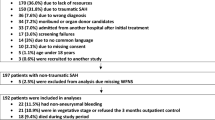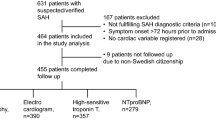Abstract
Introduction: Electrocardiographic changes, troponin release, and reduced left ventricular ejection fraction have been described after subarachnoid hemorrhage (SAH). Little is known about the occurrence of diastolic dysfunction in this setting. The purpose of this study was to determine the prevalence of diastolic dysfunction and its association with cardiac outcomes after SAH.
Methods: SAH patients were prospectively enrolled into the study, and echocardiographic, clinical, chest X-ray, and cardiac troponin I data were obtained on days 1, 3, and 6 after enrollment. Each echocardiogram included Doppler recordings of mitral inflow and pulmonary venous flow. For each study, diastolic function was categorized as normal, impaired relaxation, pseudonormal, or restrictive. The relationships between diastolic dysfunction and pulmonary edema-elevated cardiac troponin I and left ventricular contractile dysfunction were quantified using both univariate and multivariate statistical methods. Clinical predictors of diastolic dysfunction were defined by multivariate logistic regression.
Results: Of 223 enrolled subjects, 207 had technically adequate Doppler data. Diastolic dysfunction was observed in 71% of subjects. The prevalence of diastolic versus systeolic dysfunction in 44 patients with pulmonary edema was 91 versus 37%, respectively (p=0.001). After multivariate statistical adjustment, diastolic dysfunction remained a significant predictor of pulmonary edema (odds ratio [OR] 3.34, 95% CI=1.05−10.59). Diastolic dysfunction also was associated with troponin release (p=0.02). A history of hypertension and increasing age were predictive of diastolic dysfunction.
Conclusion: Diastolic dysfunction is common after SAH. It is associated with history of hypertension and older age and may explain the development of pulmonary edema in many SAH patients.
Similar content being viewed by others
References
Schievink WI. Intracranial aneurysms. N Engl J Med 1997;336:28–40.
Burch GE, Meyers R, Abildskov JA. A new electrocardiographic pattern observed in cerebrovascular accidents. Circulation 1954;9:719–723.
Mayer SA, LiMandri G, Sherman D, et al. Electrocardiographic markers of abnormal left ventricular wall motion in acute subarachnoid hemorrhage. J Neurosurg 1995;83:889–896.
Brouwers PJ, Wijdicks EF, Hasan D, et al. Serial electrocardiographic recording in aneurysmal subarachnoid hemorrhage. Stroke 1989;20:1162–1167.
Salvati M, Cosentino F, Artico M, et al. Electrocardiographic changes in subarachnoid hemorrhage secondary to cerebral aneurysm. Report of 70 cases. Ital J Neurol Sci 1992;13:409–413.
Carruth JE, Silverman ME. Torsade de pointe atypical ventricular tachycardia complicating subarachnoid hemorrhage. Chest 1980;78:886–888.
Fabinyi G, Hunt D, McKinley L. Myocardial creatine kinase isoenzyme in serum after subarachnoid haemorrhage. J Neurol Neurosurg Psychiatry 1977;40:818–820.
Kaste M, Somer H, Konttinen A. Heart type creatine kinase isoenzyme (CK MB) in acute cerebral disorders. Br Heart J 1978;40:802–805.
Neil-Dwyer G, Cruickshank J, Stratton C. Beta-blockers, plasma total creatine kinase and creatine kinase myocardial isoenzyme, and the prognosis of subarachnoid hemorrhage. Surg Neurol 1986;25:163–168.
Mayer S, Lin J, Homma S, et al. Myocardial injury and left ventricular performance after subarachnoid hemorrhage. Stroke 1999;30:780–786.
Rudehill A, Gordon E, Sundqvist K, Sylvén C, Wahlgren NG. A study of ECG abnormalities and myocardial specific enzymes in patients with subarachnoid haemorrhage. Acta Anaesthesiol Scand 1982;26:344–350.
Brouwers PJ, Westenberg HG, Van Gijn J. Noradrenaline concentrations and electrocardiographic abnormalities after aneurysmal subarachnoid haemorrhage. J Neurol Neurosurg Psychiatry 1995;58:614–617.
Horowitz MB, Willet D, Keffer J. The use of cardiac troponin-I (cTnI) to determine the incidence of myocardial ischemia and injury in patients with aneurysmal and presumed aneurysmal subarachnoid hemorrhage. Acta Neurochir (Wien) 1998;140:87–93.
Kuroiwa T, Morita H, Tanabe H, Ohta T. Significance of ST segment elevation in electrocardiograms in patients with ruptured cerebral aneurysms. Acta Neurochir (Wien) 1995;133:141–146.
Davies KR, Gelb AW, Manninen PH, Boughner DR, Bisnaire D. Cardiac function in aneurysmal subarachnoid haemorrhage: a study of electrocardiographic and echocardiographic abnorma lities. Br J Anaesth 1991;67:58–63.
Kono T, Morita H, Kuroiwa T, Onaka H, Takatsuka H, Fujiwara A. Left ventricular wall motion abnormalities in patients with subarachnoid hemorrhage: neurogenic stunned myocardium. J Am Coll Cardiol 1994;24:636–640.
Doshi R, Neil-Dwyer G, Stott A. Hypothalamic and myocardial lesions after subarachnoid hemorrhage. J Neurol Neurosurg Psychiatry 1977;40:821–826.
Kolin A, Norris JW. Myocardial damage from acute cerebral lesions. Stroke 1984;15:990–993.
Sato K, Masuda T, Kikuno T, et al. Left ventricular aynergy and myocardial necrosis accompanied by subarachnoid hemo rrhage: contribution of neurogenic pulmonary edema [in Japanese]. J Cardiol 1990;20:359–367.
Hunt W, Hess R. Surgical risk as related to time of intervention in the repair of intracranial aneurysms. J Neurosurg 1967;28:14–20.
Schiller N, Shah P, Crawford M, et al. Recommendations for quantitation of the left ventricle by two-dimensional echocardiography. American Society of Echocardiography Committee on Standards, Subcommittee on Quantitation of Two-Dimensional Echocardiograms. J Am Soc Echocardiogr 1989;2:358–367.
Pozzoli M, Capomolla S, Cobelli F, Tavazzi L. Reproducibility of Doppler indices of left ventricular systolic and diastolic function in patients with severe chronic heart failure. Eur Heart J 1995;16:194–200.
Schirmer H, Lunde P, Rasmussen K. Mitral flow derived Doppler indices of left ventricular diastolic function in a general population; the Tromso study. Eur Heart J 2000;21:1376–1386.
Bartel T, Muller S, Borges AC. Doppler-derived diastolic indices in dilated cardiomyopathy: a hemodynamic evaluation relating pre-and afterload parameters to flow velocity. Can J Cardiol 1996;12:953–958.
Firstenberg MS, Levine BD, Garcia MJ, et al. Relationship of echocardiographic indices to pulmonary capillary wedge pressures in healthy volunteers. J Am Coll Cardiol 2000;36:1664–1669.
Giannuzzi P, Imparato A, Temporelli PL, et al. Doppler-derived mitral deceleration time of early filling as a strong predictor of pulmonary capillary wedge pressure in postinfarction patients with left ventricular systolic dysfunction. J Am Coll Cardiol 1994;23:1630–1637.
Nishimura RA, Tajik AJ. Evaluation of diastolic filling of left ventricle in health and disease: Doppler echocardiography is the clinician’s Rosetta Stone. J Am Coll Cardiol 1997;30:8–18.
Angeja BG, Grossman W. Evaluation and management of diastolic heart failure. Circulation 2003;107:659–663.
Gandhi SK, Powers JC, Nomeir AM, et al. The pathogenesis of acute pulmonary edema associated with hypertension. N Engl J Med 2001;344:17–22.
Vasan RS, Larson MG, Benjamin EJ, Evans JC, Reiss CK, Levy D. Congestive heart failure in subjects with normal versus reduced left ventricular ejection fraction: prevalence and mortality in a population-based cohort. J Am Coll Cardiol 1999;33:1948–1955.
Kitzman DW, Gardin JM, Gottdiener JS, et al. Importance of heart failure with preserved systolic function in patients > or=65 years of age. CHS Research Group. Cardiovascular Health Study. Am J Cardiol 2001;87:413–419.
Jafri SM, Lavine S, Field BE, Bahorozian MT, Carlson RW. Left ventricular diastolic function in sepsis. Crit Care Med 1990;18:709–714.
Munt B, Jue J, Gin K, Fenwick J, Tweeddale M. Diastolic filling in human severe sepsis: an echocardiographic study. Crit Care Med 1998;26:1829–1833.
Poelaert J, Declerck C, Vogelaers D, Colardyn F, Visser CA. Left ventricular systolic and diastolic function in septic shock. Intensive Care Med 1997;23:553–560.
Tung P, Kopelnik A, Banki N, et al. Predictors of neurocardiogenic injury after subarachnoid hemorrhage. Stroke 2004;35:548–551.
Little WC. Hypertensive pulmonary oedema is due to diastolic dysfunction. Eur Heart J 2001;22:1961–1964.
Vasan RS, Benjamin EJ. Diastolic heart failure—no time to relax. N Engl J Med 2001;344:56–59.
Taniguchi H, Iwasaka T, Sugiura T, Takayama Y, Inada M. Pulmonary edema after anteroseptal acute myocardial infarction. Chest 1993;103:1688–1691.
Solenski NJ, Haley EC, Jr., Kassell NF, et al. Medical complications of aneurysmal subarachnoid hemorrhage: a report of the multi-center, cooperative aneurysm study. Participants of the Multicenter Cooperative Aneurysm Study. Crit Care Med 1995;23:1007–017.
Kowalski ML, Didier A, Kaliner MA. Neurogenic inflammation in the airways. Neurogenic stimulation induces plasma protein extravasation into the rat airway lumen. Am Rev Respir Dis 1989;140:101–109.
Minnear FL, Malik AB. Mechanisms of neurogenic pulmonary edema. Ann N Y Acad Sci 1982;384:169–190.
Smith WS, Matthay MA. Evidence for a hydrostatic mechanism in human neurogenic pulmonary edema. Chest 1997;111:1326–1333.
Deibert E, Barzilai B, Braverman AC, et al. Clinical significance of elevated troponin I levels in patients with nontraumatic subarachnoid hemorrhage. J Neurosurg 2003;98:741–746.
Rakowski H, Appleton C, Chan KL, et al. Canadian consensus recommendations for the measurement and reporting of diastolic dysfunction by echocardiography: from the Investigators of Consensus on Diastolic Dysfunction by Echocardiography. J Am Soc Echocardiogr 1996;9:736–760.
Appleton CP, Jensen JL, Hatle LK, Oh JK. Doppler evaluation of left and right ventricular diastolic function: a technical guide for obtaining optimal flow velocity recordings. J Am Soc Echocardiogr 1997;10:271–292.
Mayer SA, Fink ME, Homma S, et al. Cardiac injury associated with neurogenic pulmonary edema following subarachnoid hemorrhage. Neurology 1994;44:815–820.
Pollick C, Cujec B, Parker S, Tator C. Left ventricular wall motion abnormalities in subarachnoid hemorrhage: an echocardiographic study. J Am Coll Cardiol 1988;12:600–605.
Zaroff JG, Rordorf GA, Ogilvy CS, Picard MH. Regional patterns of left ventricular systolic dysfunction after subarachnoid hemorrhage: evidence for neurally mediated cardiac injury. J Am Soc Echocardiogr 2000;13:774–779.
Kantor HL, Krishnan SC. Cardiac problems in patients with neurologic disease. Cardiol Clin 1995;13:179–208.
Oppenheimer S, Wilson J, Guiraudon C, et al. Insular cortex stimulation produces lethal cardiac arrhythmias: a mechanism of sudden death? Brain Res 1991;550:115–121.
Cesari M, Penninx BW, Newman AB, et al. Inflammatory markers and cardiovascular disease (The Health, Aging and Body Composition [Health ABC] Study). Am J Cardiol 2003;92:522–528.
Vasan RS, Sullivan LM, Roubenoff R, et al. Inflammatory markers and risk of heart failure in elderly subjects without prior myocardial infarction: The Framingham Heart Study. Circulation 2003;107:1486–1491.
Kapadia SR, Yakoob K, Nader S, Thomas JD, Mann DL, Griffin BP. Elevated circulating levels of serum tumor necrosis factor-alpha in patients with hemodynamically significant pressure and volume overload. J Am Coll Cardiol 2000;36:208–212.
Matsumori A, Yamada T, Suzuki H, Matoba Y, Sasayama S. Increased circulating cytokines in patients with myocarditis and cardiomyopathy. Br Heart J 1994;72:561–566.
Milo O, Cotter G, Kaluski E, et al. Comparison of inflammatory and neurohormonal activation in cardiogenic pulmonary edema secondary to ischemic versus nonischemic causes. Am J Cardiol 2003;92:222–226.
Garner LB, Willis MS, Carlson DL, et al. Macrophage migration inhibitory factor is a cardiac-derived myocardial depressant factor. Am J Physiol Heart Circ Physiol 2003;285: H2500-H2509.
Kikuchi T, Okuda Y, Kaito N, Abe T. Cytokine production in cerebrospinal fluid after subarachnoid haemorrhage. Neurol Res 1995;17:106–108.
Kwon KY, Jeon BC. Cytokine levels in cerebrospinal fluid and delayed ischemic deficits in patients with aneurysmal subarachnoid hemorrhage. J Kor Med Sci 2001;16:774–780.
Mathiesen T, Edner G, Ulfarsson E, Andersson B. Cerebrospinal fluid interleukin-1 receptor antagonist and tumor necrosis factor-alpha following subarachnoid hemorrhage. J Neurosurg 1997;87:215–220.
Gruber A, Rossler K, Graninger W, Donner A, Illievich MU, Czech T. Ventricular cerebrospinal fluid and serum concentrations of sTNFR-I, IL-1ra, and IL-6 after aneurysmal subarachnoid hemorrhage. J Neurosurg Anesthesiol 2000;12:297–306.
Hirashima Y, Nakamura S, Endo S, Kuwayama N, Naruse Y, Takaku A. Elevation of platelet activating factor, inflammatory cytokines, and coagulation factors in the internal jugular vein of patients with subarachnoid hemorrhage. Neurochem Res 1997;22:1249–1255.
Author information
Authors and Affiliations
Corresponding author
Rights and permissions
About this article
Cite this article
Kopelnik, A., Fisher, L., Miss, J.C. et al. Prevalence and implications of diastolic dysfunction after subarachnoid hemorrhage. Neurocrit Care 3, 132–138 (2005). https://doi.org/10.1385/NCC:3:2:132
Issue Date:
DOI: https://doi.org/10.1385/NCC:3:2:132




